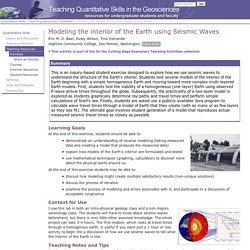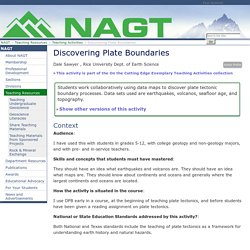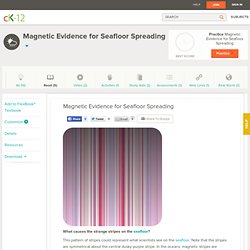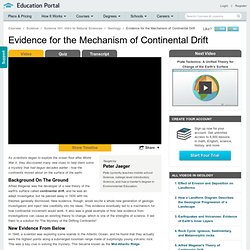

Seimic Waves and Earth’s Interior. Modeling the interior of the Earth using Seismic Waves. Eric M.

D. Baer, Dusty Wilson, Tina Ostrander Highline Community College, Des Moines, Washington Author Profile This activity was selected for the On the Cutting Edge Exemplary Teaching Collection Resources in this top level collection a) must have scored Exemplary or Very Good in all five review categories, and must also rate as “Exemplary” in at least three of the five categories. Scientific Accuracy Alignment of Learning Goals, Activities, and Assessments Pedagogic Effectiveness Robustness (usability and dependability of all components) Completeness of the ActivitySheet web page For more information about the peer review process itself, please see This page first made public: Mar 28, 2006 Summary This is an inquiry-based student exercise designed to explore how we use seismic waves to understand the structure of the Earth's interior.
Learning Goals Context for Use I use this lab in both an intro-physical geology class and a non-majors seismology class. Teaching Notes and Tips Assessment. Incorporated Research Institutions for Seismology. Oceanic crust – that sinking feeling. Some rocks lead a quiet life.

Stable parts of continental crust just sit there for billions of years, doing nothing. In the oceans things are much more dynamic. Live fast, die young, stay pretty is the motto of oceanic crust. It goes on one of the most amazing journeys rock can take. Along the way it affects well nigh everything in and on the planet. Making the crust Mantle material, usually made of a dark heavy rock called peridotite, is odd stuff. Our little piece of oceanic crust is about to be formed at a mid-ocean ridge, where two plates move apart. Pillow basalts. All of this is taking place under water. That sinking feeling As our new crust slowly drifts at finger-nail speed (5 cm/yr) away from the ridge, it cools and grows denser, causing the sea-bed to sink.
After 50Ma (million years) our crust is denser than the underlying mantle. As it moves down into the subduction zone, our crust is pushed down under another plate. Subduction zones and mid-ocean ridges are linked. Discovering Plate Boundaries. Dale Sawyer Rice University Dept. of Earth Science Author Profile This activity was selected for the On the Cutting Edge Exemplary Teaching Collection Resources in this top level collection a) must have scored Exemplary or Very Good in all five review categories, and must also rate as “Exemplary” in at least three of the five categories.

Pltect.pdf. Seafloor_spreading.pdf. Developing the theory [This Dynamic Earth, USGS] Continental drift was hotly debated off and on for decades following Wegener's death before it was largely dismissed as being eccentric, preposterous, and improbable.
![Developing the theory [This Dynamic Earth, USGS]](http://cdn.pearltrees.com/s/pic/th/developing-the-theory-92924604)
However, beginning in the 1950s, a wealth of new evidence emerged to revive the debate about Wegener's provocative ideas and their implications. In particular, four major scientific developments spurred the formulation of the plate-tectonics theory: (1) demonstration of the ruggedness and youth of the ocean floor; (2) confirmation of repeated reversals of the Earth magnetic field in the geologic past; (3) emergence of the seafloor-spreading hypothesis and associated recycling of oceanic crust; and (4) precise documentation that the world's earthquake and volcanic activity is concentrated along oceanic trenches and submarine mountain ranges.
Ocean floor mapping. Magnetic Evidence for Seafloor Spreading ( Read ) What causes the strange stripes on the seafloor?

This pattern of stripes could represent what scientists see on the seafloor. Note that the stripes are symmetrical about the central dusky purple stripe. In the oceans, magnetic stripes are symmetrical about a mid-ocean ridge axis. What could cause this? What could it possibly mean? Seafloor Magnetism On our transit to the Mid-Atlantic ridge, we tow a magnetometer behind the ship. When scientists plotted the points of normal and reversed polarity on a seafloor map they made an astonishing discovery: the normal and reversed magnetic polarity of seafloor basalts creates a pattern. Www.geosociety.org/educate/LessonPlans/SeaFloorSpreading.pdf. Evidence for the Mechanism of Continental Drift Video - Lesson and Example.
Background on the Ground Alfred Wegener was the developer of a new theory of the earth's surface called continental drift, and he was an adept investigator, but he passed away in 1930 with his theories generally dismissed.

New evidence, though, would excite a whole new generation of geologic investigators and inject new credibility into his ideas. This evidence eventually led to a mechanism for how continental movement would work. It also was a great example of how new evidence from investigations can cause an existing theory to change, which is one of the strengths of science. It led them to a solution for 'The Mystery of the Drifting Continents! ' New Evidence from Below In 1948, a scientist was exploring some islands in the Atlantic Ocean, and he found that they actually were the highest points along a submerged mountain range made of surprisingly young volcanic rock. Deep ocean trenches were found in specific locations on the ocean floor. Tea Bag Rockets Convection Current fire Experiment. Plate tectonics/MSPlatetectonicsunit.pdf. Teaching Plate Tectonics.